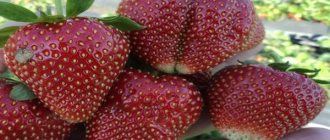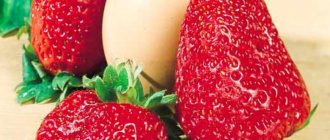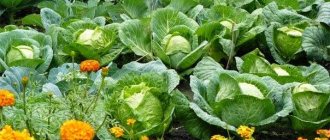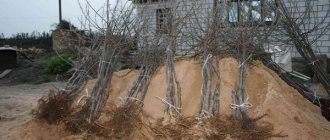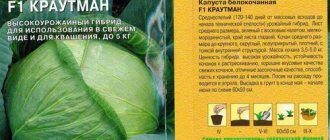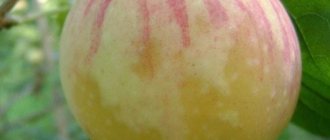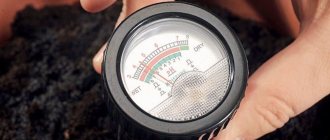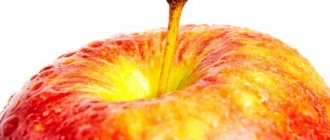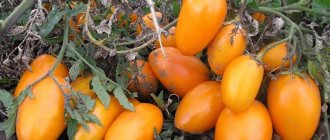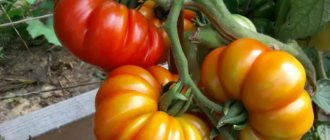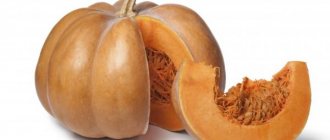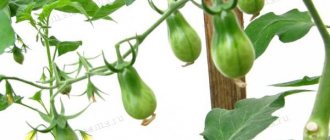Gardening » Apple tree
0
591
Article rating
Kira Stoletova
The Medunitsa apple tree is a summer variety bred in the USSR in the 30s. He has not yet entered the register, because... no one can determine its exact yield. The fruits are so tasty that they are eaten even before they are fully ripe. The variety is well adapted for cultivation in temperate climates and northern latitudes.
Sweet apple tree Lungwort
Characteristics of the variety
The Lungwort apple tree has a delicate honey aroma, but the name of the variety is not associated with this at all.
Her creator, Professor Isaev, gave her the name that he affectionately called his wife in his youth. He also associated the name with the spring flower Lungwort.
The ancestors of the variety were Cinnamon Striped and Welsey. The result is a variety with an unusually sweet taste and high winter hardiness. It was specially bred for cultivation in cold regions.
Description of the tree and fruits
Description of the apple tree Lungwort:
- Tree height – 5-7 m
- The crown is pyramidal, with the apex at the bottom
- Drooping branches
- The rate of shoot formation is average
- Foliage color – light green
The flowers are large, can reach 5 cm in diameter. The petals are white with a slight pink tint.
Description of fruits:
- The apples are medium in size, they weigh 90-150 g
- Round shape, slightly flattened at the poles
- The ribbing is quite clearly visible on the surface
- Primary color – green-yellow, blush in the form of stripes, blurred pattern
- The pulp is cream or yellowish, fine-grained, juicy
An apple contains almost 14% sugar and very few acids. The amount of vitamin C is 8 mg/100 g.
The fruit contains about 5 mg/100 g of chlorogenic acid, which promotes the excretion of oxalic acid. Therefore, they are recommended for gout.
Quercetin in the peel plays the role of an antioxidant, it prevents atherosclerosis and neutralizes the effects of free radicals. Pectins help remove heavy metals.
Productivity
Lungwort is a fairly productive variety: up to 80 kg of fruit is harvested from an apple tree. More mature trees can produce up to 180 kg of fruit.
The yield is stable, only after 20 years there may be breaks in fruiting for a year. Such indicators allow it to be grown on an industrial scale.
Taste
The taste characteristics of apples are quite high.
Due to the high sugar content, the pulp is very sweet, the sourness is practically not felt, but there are clear notes of honey. Even unripe green fruits are already sweet.
The pulp is juicy and crispy. The aroma is pronounced, honey notes are felt. Unfortunately, already two weeks after harvesting, the honey taste and smell disappears.
Pollinator varieties
The presence of pollinators will increase crop yields
According to the description, the variety is considered self-fertile: apple pollen is capable of fertilizing the pistils of flowers on the same tree, but in the presence of pollinators, the yield of Lungwort increases and more ovaries are formed.
When choosing a pollinator, you need to focus on the flowering period. At Medunitsa it occurs at the end of May and beginning of June. Anis Sverdlovsky, Cinnamon striped, Kerr, Zolotaya, Pobeda have approximately the same terms.
The distance between apple trees should be no more than 50 m. There can be no more than 10-12 trees per pollinator.
Winter hardiness
One of the main tasks when breeding the variety was to develop good resistance to frost.
The breeders managed to completely cope with it. Young seedlings can withstand temperatures down to -20⁰C, old ones - down to -30⁰C.
Even after freezing, many branches are able to regenerate. But after a harsh winter, the tree is definitely worth inspecting and removing dead twigs.
Resistance to diseases and pests
The variety is resistant to scab and fruit rot.
These fungal diseases never affected the tree, even if diseased plants were nearby.
Application of fruits
The Lungwort apple is unusually sweet, even when not fully ripe, and has a subtle honey aroma.
The produce can be grown for sale. But it needs to be implemented quickly, because... The fruits are poorly stored.
Apples make very tasty jams and preserves. The fruits are processed into juices and jam.
Types of rootstocks and varieties variations
A number of characteristics of the future apple tree depend on the rootstock of Lungwort: the height and width of the crown, the beginning of fruiting and life expectancy.
Depending on the rootstock, a planting scheme is chosen. There are also variety options.
Seed rootstock
The seed rootstock is the classic type.
The tree grows up to 5-7 m, the first fruits appear at 5-6 years. The crown is wide, pyramidal.
Apple trees live up to 80-90 years, and maintain high yields for 50-70 years. They need to be planted at a distance of 4.5-5.5 m from each other. The variety requires regular pruning.
Semi-dwarf rootstock
The height of the apple tree is 4-4.5 m, it begins to produce a harvest at 3.5-4.5 years. Lives quite a long time, although less than the classic one.
An important characteristic of the rootstock is the ability to grow at high groundwater levels.
Trees should be planted at a distance of 3 m. Semi-dwarf rootstock is considered the best for industrial cultivation.
Dwarf and columnar rootstock
Small trees on dwarf rootstocks are becoming increasingly popular.
The Lungwort seedling takes root well on the following species: the apple tree reaches 1.5 to 2.5 m in height, fruiting begins early, the first ovaries appear already in the second year after planting.
Dwarf rootstock is not durable
The disadvantage is the short life expectancy. After only 12 years, productivity drops sharply, and after another year or two the tree dries out.
According to the recommendations of gardeners, small apple trees must be tied up. They have a weak root system; any load or strong gusts of wind can damage it.
There is no point in grafting this variety onto a columnar rootstock. The main feature of the rootstock is a narrow crown with branches growing parallel to the trunk. After grafting, the growth of branches will be disrupted.
Winter lungwort
It differs from summer only in terms of ripening and storage of fruits.
at Winter Lungwort they reach condition at the end of September, can remain until spring, have a sweet honey taste and denser flesh.
Prevention and control of diseases and pests
Although Lungwort is highly resistant to fungal diseases, it requires regular preventative treatment. With the onset of spring, it is recommended to treat it with a solution of copper sulfate. To get rid of pests, you can use elderberry tincture. Bordeaux mixture will help against rot and scab.
Scab on leaves
With proper care of Lungwort, it will delight the owner with an abundant and tasty harvest for at least 10 years.
Planting a variety
After choosing a variety, be sure to familiarize yourself with the features of its planting. Sometimes a description of the process is included with the seedlings, but not all nurseries provide such instructions.
Landing dates
Planting dates depend on the region and take into account the likelihood of frost, which can damage young plants.
For the Moscow region and the Leningrad region, late spring frosts are more typical, for the Urals and Siberia - early autumn ones. In addition, winters are harsher in the north.
Therefore, in regions with a temperate climate, it is recommended to plant apple trees in the fall, 3 weeks before the expected frost. In the north, it is better to do this in the spring, so that the winter cold does not destroy the trees. When planting in spring, you must wait until the soil melts at a depth of 60-80 cm.
Landing location
The Medunitsa variety is unpretentious to the soil: the apple tree can grow on loam and sandy soil. But the more fertile the land, the higher the yield.
When planting, be sure to take into account the groundwater level. Only the variety on a semi-dwarf rootstock tolerates their high standing well. Other types may die under such conditions.
The place should be protected from wind and draft. It’s good if the future apple tree is evenly illuminated by the sun - this way you can achieve greater synchronicity in the ripening of the fruits.
Selection and preparation of seedlings
It is better to buy seedlings in specialized nurseries, preferably in a tub, then you can see their foliage and you can assess their condition. If these are not available for sale, take them with a clod of earth, and not with bare roots.
The bark should be smooth, have a light brown tint, and a medium edge. Particular attention should be paid to the sheets; they should be narrow and elongated, with slight relief and bending.
When transporting, the roots should be wrapped in film, hay or moss. Immediately before planting, the root system can be carefully freed from the soil.
Landing technology
The pit must be prepared in advance
When planting in autumn, the pit is prepared 4-5 weeks in advance; for spring planting, from the fall.
Its dimensions should be approximately 50x50x50 cm (10-15 cm larger for three-year-old seedlings). A drainage layer 15-20 cm thick is laid at the bottom of the pit. Small pebbles, crushed stone or expanded clay are suitable.
Fertile soil, which was pulled out of the hole, is mixed with complex mineral fertilizer and compost. Then they fall asleep again in the hole. The place is left in this state for several weeks (or for the winter).
Before planting, drive a peg into the hole. Then the seedling is placed in the center, having first straightened its roots. Sprinkle with earth so that the root collar rises 3-4 cm above the mound. Finally, water with 2-3 buckets of water.
Apple tree Lungwort: planting and growing
Rules for planting and caring for the Lungwort apple tree
- are quite traditional and only some nuances of growing the variety should be taken into account.
Landing
Seedlings of the Medunitsa variety should be planted at the same time as other varieties of apple trees - in early spring or late autumn.
. In the middle zone, this apple tree should be planted in the fall, but in the Urals or Siberia it is better in the spring - in this case, the seedlings will have time to take root well before the onset of severe cold.
When planting Medunitsa fruit trees in the fall, you need to calculate the time so that at least 20-25 days remain before the onset of frost. It is better not to plant trees before, since in warm weather they will actively grow shoots that will not have time to lignify and will freeze in winter.
How to plant Medunitsa apple trees - video
Planting pits are prepared in the fall (if you plan to plant plants in the spring) or in the spring - when planting them in the autumn.
The excavated soil is mixed with fertilizers and the hole is filled halfway. A stake is driven into its center, to which the tree will be tied after planting. The seedling is placed in the center, the roots are carefully straightened, covered with the remaining nutrient substrate, compacted and watered - at least 10-15 liters of water are poured under each tree.
Rules of care
Lungwort apple trees require standard care, which includes:
- Watering
- Fertilizer application
- Pruning
- Prevention of diseases and pest damage to trees
Watering
You should not water the apple tree too much. In dry weather, it is enough to pour 4-5 buckets of water under an adult tree twice a month.
If the summer is rainy, carry out one-time watering every 30-40 days.
Young seedlings need more intensive watering. They need to be watered once a week with 1-2 buckets of water.
Feeding
Fertilizers begin to be applied to the soil in the second year after planting. Feeding is done twice per season.
In the spring, before flowering begins, nitrogen is added. You can use organic fertilizers (mullein diluted with water 1:10 or litter 1:30). Humus or rotted manure is also suitable. You can feed Lungwort with urea.
In autumn, the apple tree needs potassium, phosphorus and calcium. These elements increase frost resistance and help you survive the winter safely. 90-100 g of superphosphate and 35 g of potassium chloride are added under the roots. You can replace them with the usual complex fertilizing for fruit crops.
Trimming
The apple tree variety Lungwort needs regular pruning - this is the basic rule of care. They begin to form the crown from the second year after planting.
It is best to create several tiers of branches, the distance between which will be 30-40 cm. The bowl option is also suitable, when the upper branches are cut off and growth is ensured by 4-5 side shoots. Then the tree will not be too tall, which will make it easier to collect fruit.
Every spring, sanitary pruning is carried out, diseased and damaged branches are removed. At the same time, the crown is thinned out. In summer, you can pinch and remove shoots that shade the fruit.
After each procedure, the “wounds” are covered with garden varnish. Spring work begins before the buds begin to swell and the tree sap begins to circulate.
Pest and disease control
Lungwort is relatively rarely affected by fungi. But for prevention, it is recommended to spray it with copper sulfate or Bordeaux mixture in the spring.
Spraying will get rid of pests
Urea prevents diseases well. It is used to treat branches during the formation of ovaries.
At the first symptoms of fungal pathologies, it is recommended to use fungicides.
Insecticides are used to control insect pests. You can also spray the tree with a soap solution, infusion of dill, garlic or tobacco. For prevention in the spring, it is worth whitewashing the tree trunk with lime.
In autumn, all the leaves are removed from the garden and the ground is dug up. If the trees were sick in the summer, remove all damaged branches. The soil is treated with antifungal drugs and insecticides.
Possible difficulties during cultivation
The Lungwort variety is characterized by good immunity and is rarely affected by diseases and pests, but with improper care the risk of a problem increases. In addition, since the development of this variety, new varieties of scab have appeared that can infect trees under certain conditions. The main types of diseases and pests that can threaten the Lungwort apple tree are listed below:
- Common scab. This fungal disease affects leaves and fruits. They become covered with brown spots, which gradually increase in size and affect all parts of the tree. The leaves begin to dry out and fall off, and the apples rot. To get rid of scab, all infected areas are removed, and the apple tree is irrigated with antifungal drugs (for example, Topaz).
- Fruit rot. The disease affects inflorescences unnoticed and appears only after the flowering process is completed. Small brown spots form on the ovaries and fruits, which over time spread to the entire fruit and cause it to rot. Spoiled fruits must be removed from the tree, as they contain fungal colonies and contribute to the further spread of infection. The crown of a diseased apple tree is sprayed with a solution of colloidal sulfur.
- Powdery mildew. The source of infection is a fungus that affects the leaves and shoots of the tree. As a result of this, they become covered with a powdery white coating, dry out and die, and the inflorescences and fruit ovaries crumble. To get rid of the source of infection, you need to cut and burn all the affected leaves, and treat the crown of the apple tree with special preparations (for example, “Skorom”).
- Medyanitsa (leaf). In the spring, larvae hatch from eggs laid on tree branches and suck the juice from the leaves, petioles and buds. A sticky white coating is clearly visible on the affected areas, and leaves and inflorescences begin to fall off en masse. To treat an apple tree, you need to remove all affected areas from it and treat it with insecticides.
- Shield. The larvae of this pest appear on the apple tree after it blooms and stick to the surface of the branches and shoots. They drink sap from the tree bark and lead to the gradual death of shoots along with leaves and fruits. To get rid of scale insects, the crown of the apple tree is generously irrigated with insecticides.
To prevent these problems, it is recommended to implement the following preventive measures:
- regularly inspect trees for early detection of signs of disease and pest damage;
- spray the apple tree with an aqueous solution of copper sulfate in early spring before buds open (you will need 100 g of product per bucket of water);
- before flowering, add a 10% nitrate solution to the soil around the trunk, and irrigate the tree crown with 3% Bordeaux mixture;
- whitewash the trunk in the fall after harvesting the fruits and in the early spring before the buds open;
- dig up soil in the tree trunk circle in spring and autumn to destroy pest larvae;
- remove fallen leaves and rotten fruits from the surface of the soil around the tree;
- pruning in a timely manner to improve air circulation inside the tree crown.
Sedums. Prominent and enviable
We recommend that you familiarize yourself with the peculiarities of growing apple tree varieties: Lobo, Red Delicious, Zhigulevskoe.
Features of ripening and fruiting
According to the description of the variety, the beginning of fruiting of Lungwort depends on the rootstock: on a seed rootstock it is 5-6 years after planting the apple tree, on a semi-dwarf rootstock - 3-4 years, on a dwarf rootstock - 2-3 years.
The greatest productivity is at the age of 8-12 years. After this, the dwarf varieties sharply lose their ability to produce crops. Tall types can bear fruit for up to 50-70 years.
Summer Lungwort begins to ripen in mid-August, and winter Lungwort begins to ripen in late September or early October. The apples take on a yellow-green hue, then red stripes appear on their surface. Over time, they become less clear and blurry. If the fruit is facing the sun, it may turn completely red. In a shaded area, even ripe apples remain yellow and slightly striped.
One of the features of ripening is unevenness. Some fruits are ready for consumption already in the first ten days of August, others only at the beginning of September. This is due to the high dependence of the ripening of the variety on lighting and sunlight.
If apples grow in the shade, covered with leaves, they take longer to reach condition.
Answers to readers' questions
Readers most often have questions related to the fruiting of Lungwort. We will try to answer them.
How much do seedlings cost?
The price of seedlings depends on the rootstock, the age of the apple tree, the integrity of the root system, the region and the seller’s brand. For example, at the beginning of 2021, in the nursery of Vladimir you can find seedlings on a rootstock 54-118 cm from 400 to 700 rubles per piece (container 3-10 liters), and 25,000 rubles per seedling in a container 65-110 liters.
The most expensive will be a columnar or dwarf seedling over three years old, grown in a container. The apple tree is already bearing fruit and the buyer immediately sees that he has the right variety in front of him. You can transplant the plant into the garden without damaging the root system.
is much cheaper to purchase a seedling on a seed rootstock with an open root system. In this case, you will have to wait 5-6 years to get the first harvest and ensure varietal compliance. The height of the tree over the years of development can increase to 7-8 meters.
What year does it begin to bear fruit?
The beginning of fruiting of Lungwort can be determined by the rootstock. The smaller it is, the shorter the waiting period for the harvest. The average age at which Lungwort begins to bear fruit is 5 years.
Why doesn't it bear fruit?
If the apple tree not only does not bear fruit, but also does not bloom, perhaps it has not yet reached the age of fruiting or the buds have been damaged by return frosts;
If the apple tree blooms, but the fruits do not set, this may be due to poor pollination of the tree or to pests that destroy the flowers.
Fruits of Lungwort.
How to care during flowering?
During flowering, Lungwort should create good conditions for pollination . This will increase the yield of young trees. bee-attracting compositions based on honey and sugar are hung on trees . You can place containers with water in the crown of Lungwort and put flowering branches of another summer variety in them.
When to harvest?
Lungwort can be summer or winter . summer lungwort apples are harvested at the end of August.
In warmer regions it may shift to the beginning of the month, and in colder regions to the end of summer. Winter Lungwort is ready for harvest in late September - early October.
Harvest and storage
Harvesting begins during the period of technical ripeness: Summer Lungwort ripens by mid-August, and winter apple trees - in the last ten days of September. At this time, the apples are green-yellow with sparse red stripes on the sides.
If you collect technically ripe fruits, they will be stored longer. For the summer variety, this period can be extended to 2.5 months. Winter ones can last until mid-March.
In order for the fruits to be well preserved, they are picked together with the stalks, each one is wrapped in thin paper and placed in boxes. Then place it in a cool place, the temperature should not exceed 5⁰C.
If the harvest is abundant, it is better to process some of the fruits. First of all, this concerns the summer Lungwort.
Productivity of the Medunitsa apple tree variety
Since the variety is not included in the State Register, experts do not give specific recommendations on the zoning of this apple tree. However, Lungwort is highly resistant to frost, so it can be grown in most regions of Russia, while neither the branches nor the flower buds of the tree freeze out.
As a result, apple trees of this variety still grow in many gardens in the south of the country, in the Central, Central Black Earth regions, and in many regions of the Urals and Siberia. In more northern areas, only the semi-dwarf variety of Lungwort is grown.
The first fruits from planted seedlings are collected in the fifth season from the moment of planting (from summer and winter varieties). Semi-dwarf species begin to bear fruit already in the third season, and dwarf species - in the second season. The productivity of the summer variety of apple tree Medunitsa is the highest - up to 160-170 kg from one mature tree.
Due to the fact that the crown is quite dense, the ripening of apples occurs unevenly, so the summer apple tree Medunitsa is harvested from the second ten days of August to the first ten days of September.
You can also note the peculiarity of this variety - the fruiting of Lungwort is irregular
– after a particularly active season, the tree usually rests in the next one. In general, Lungwort can bear fruit for up to 45-48 years, sometimes (with good care) longer. But active fruiting occurs in the first 13-15 years from the moment the first apples appear.
Apple tree processing!
• Fungicide Antrakol - instructions for use and benefits
Important!
One of the positive qualities of Lungwort is that even ripe fruits stick well to the branches, so there is practically no carrion under these trees.
Reviews from gardeners
The Medunitsa apple tree varieties are popular among gardeners. Everyone notes the original taste of apples; they have no sourness. The subtle honey aroma is also praised. Unfortunately, it quickly disappears during storage.
All reviews talk about the high yield of the variety. Already in 7-8 years, almost a hundredweight of fruit can be collected from one tree. Young apple trees bear fruit regularly; only after too abundant harvests can they be interrupted for a year.
On old trees, it is recommended to regulate the number of ovaries so that they bear fruit annually.
According to reviews, shelf life is short. But this is not the biggest drawback. After all, apples are so tasty that the family eats them in a couple of weeks. Many say that there is not even enough left for recycling. The tree practically does not require treatment against diseases and pests. You can easily get by with harmless folk remedies.
History of selection of Lungwort
Isaev S.I. began breeding work on developing a new variety, the distinctive feature of which should be frost resistance, in the early 30s of the last century. Thanks to his activities, the catalog of varietal fruit trees has been expanded to include more than 40 different varieties, distinguished not only by winter hardiness, but also by resistance to various fungal diseases. The Medunitsa apple tree variety was developed by crossing the Canadian variety Welsey and the Cinnamon Striped variety.
But this apple tree received the name “Lungwort” not for the aroma and taste of honey that its fruits possess. Rather, the breeder gave this name to the apple tree in honor of the flower of the same name, which is among the first to bloom in the spring. In addition, the biologist called his beloved wife “Medunitsa.” The apple tree has several other names - “Honey”, “Honey”.
For excellent breeding activities and excellent qualities of the Medunitsa apple tree, the professor was awarded the Stalin Prize. But, despite all the merits and the enormous work done, Medunitsa and many other varieties he bred were never registered in the State Register.
